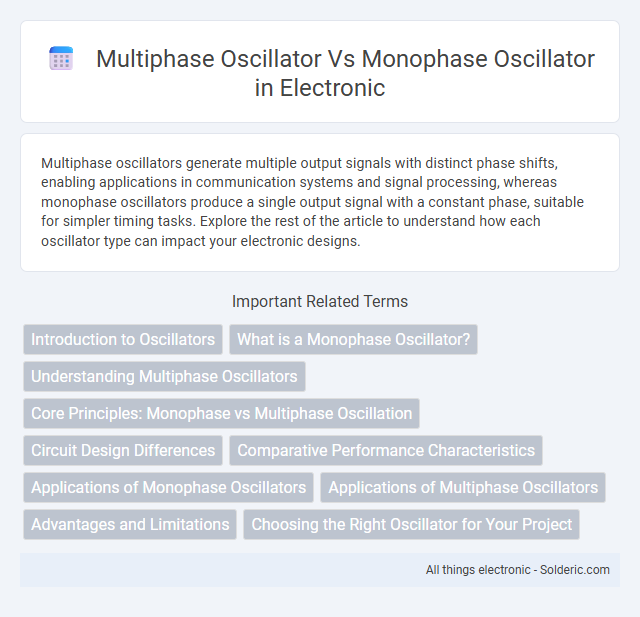Multiphase oscillators generate multiple output signals with distinct phase shifts, enabling applications in communication systems and signal processing, whereas monophase oscillators produce a single output signal with a constant phase, suitable for simpler timing tasks. Explore the rest of the article to understand how each oscillator type can impact your electronic designs.
Comparison Table
| Feature | Multiphase Oscillator | Monophase Oscillator |
|---|---|---|
| Output Phases | Multiple phases (typically more than two) | Single phase output |
| Applications | Used in polyphase systems, phase-shift circuits, and motor drives | Used in simple timing and single waveform generation |
| Complexity | Higher complexity with additional phase shift networks | Simpler design and fewer components |
| Waveforms | Multiple synchronized waveforms with fixed phase differences | One waveform output only |
| Examples | Three-phase oscillator, quadrature oscillator | Colpitts, Hartley, Pierce oscillators |
| Frequency Stability | Can be less stable due to phase network complexity | Generally more stable and easier to control |
| Use in Signal Processing | Enables phase-related signal processing like mixers and modulators | Typically used for single frequency generation and timing |
Introduction to Oscillators
Oscillators generate periodic signals essential for timing and waveform generation in electronic circuits. A monophase oscillator produces a single output phase, commonly used in basic timing applications, while a multiphase oscillator generates multiple phase-shifted signals, crucial for complex systems like three-phase motor control and advanced communication technologies. Your choice between these oscillators depends on the required signal complexity and synchronization needs.
What is a Monophase Oscillator?
A Monophase Oscillator generates a single sinusoidal output frequency, producing one phase of an oscillating signal typically used in simple AC power systems. Unlike Multiphase Oscillators, which produce multiple phases (such as three-phase systems for industrial motors), the Monophase Oscillator is simpler and often utilized in residential electrical applications. Your choice depends on the complexity and power requirements, with Monophase being ideal for low-power, single-phase circuits.
Understanding Multiphase Oscillators
Multiphase oscillators generate multiple output signals with distinct phase shifts, enabling improved timing accuracy and reduced signal distortion in applications like communication systems and digital signal processing. Unlike monophase oscillators that produce a single-phase output, multiphase oscillators support complex modulation schemes and higher-frequency synthesis by providing various phase references. Understanding multiphase oscillators helps you optimize circuit design for precise phase control and enhanced performance in multi-channel or multi-frequency environments.
Core Principles: Monophase vs Multiphase Oscillation
Monophase oscillators generate a single sinusoidal output waveform based on a single LC or RC feedback loop, producing one stable frequency with consistent amplitude. Multiphase oscillators create multiple outputs with equal amplitude but shifted phases, commonly used for driving polyphase systems or digital circuits requiring timing signals. Your choice depends on the application, where monophase suits simple RF signals and multiphase supports complex signal processing or motor control requiring phase synchronization.
Circuit Design Differences
Multiphase oscillators utilize multiple phase-shift networks or coupled resonators to generate several output signals with fixed phase differences, requiring more complex circuit topologies compared to monophase oscillators. Monophase oscillators typically rely on a single feedback loop and resonant tank circuit producing one sinusoidal output, leading to simpler design and fewer components. The design of multiphase oscillators demands careful balancing of phase shifts and amplitudes to maintain stable multi-output configurations, whereas monophase designs focus predominantly on frequency stability and amplitude control.
Comparative Performance Characteristics
Multiphase oscillators generate multiple output signals with distinct phase shifts, enhancing signal processing in communication systems by reducing phase noise and improving spectral purity compared to monophase oscillators, which produce a single-phase output. The stability and noise immunity of multiphase oscillators make them ideal for applications like quadrature modulation and synchronous detection, where precision timing is critical. Your choice between these oscillators depends on the need for phase diversity and signal integrity in complex electronic systems.
Applications of Monophase Oscillators
Monophase oscillators are widely used in applications requiring stable single-frequency signals, such as in clock generation for digital circuits, radio-frequency transmitters, and audio signal processing. Their simplicity and reliability make them ideal for consumer electronics, telecommunications, and instrumentation. You can rely on monophase oscillators for precision timing and consistent waveform generation in various electronic devices.
Applications of Multiphase Oscillators
Multiphase oscillators are essential in applications requiring multiple signal phases such as communication systems, phase-locked loops, and multi-phase motor control. They provide balanced outputs for synchronous digital circuits, improving signal integrity and timing accuracy over monophase oscillators. Your design benefits from multiphase oscillators by enabling better phase noise performance and enhanced system stability in complex electronic devices.
Advantages and Limitations
Multiphase oscillators provide improved signal stability and reduced harmonic distortion compared to monophase oscillators, making them ideal for applications requiring precise phase control like communication systems and signal processing. However, multiphase oscillators are more complex and costly to design and implement, often requiring intricate circuitry that increases power consumption and size. Monophase oscillators offer simplicity and lower power usage, but they lack the phase-shift capabilities essential for tasks demanding multi-phase signals, limiting their functionality in advanced electronic applications.
Choosing the Right Oscillator for Your Project
Choosing the right oscillator for your project depends on the signal requirements and complexity of the application. Multiphase oscillators generate multiple output signals with phase shifts, ideal for motor control and signal processing applications needing precise phase relationships, while monophase oscillators provide a single stable frequency output suitable for simpler timing and clock circuits. Assessing factors such as phase accuracy, output stability, and integration complexity ensures optimal performance and efficiency in your project's design.
Multiphase oscillator vs Monophase oscillator Infographic

 solderic.com
solderic.com